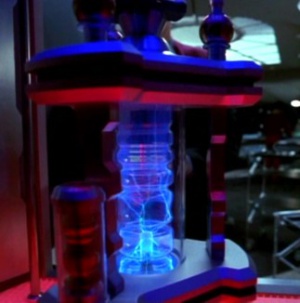Coaxial warp drive
A coaxial warp drive (also known as a coaxial induction drive or a differential induction drive) is a propulsion system that folds space in on itself, allowing instantaneous travel over huge distances.
In the 24th century, it was believed by Star Fleet scientists and engineers to be a purely hypothetical technology. However, a functioning coaxial warp ship was encountered by the Federation starship USS Voyager in 2374.
The ship was experimental and unstable when it emerged from warp, threatening to explode with the theoretical possibility of collapsing space within a radius of a billion kilometers. Lieutenant Tom Paris suggested a symmetric warp field to contain any instabilities in its space-folding core, averting the explosion.
The coaxial core functioned by drawing in subatomic particles and reconfiguring their internal geometries. However, the particles were unstable and kept overloading the engines. Inspired by an ancient Earth device, the carburetor, Paris suggested installing a polaric modulator to dilute the subatomic energy flow before it entered the core, which solved the problem.
